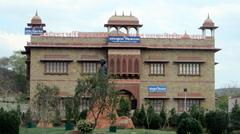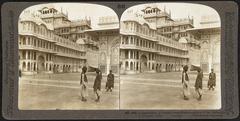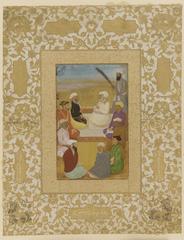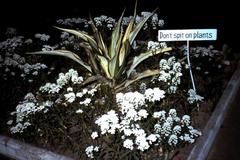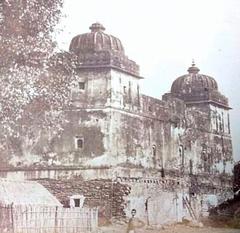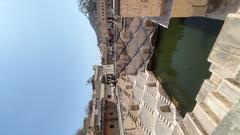
University of Rajasthan Jaipur: Visiting Hours, Tickets, and Historical Significance
Date: 14/06/2025
Introduction
The University of Rajasthan, situated in Jaipur, India, stands as a beacon of higher education, heritage, and architectural brilliance. Founded in 1947 as the University of Rajputana and renamed in 1956, it is not only one of Rajasthan’s oldest academic institutions but also a vital cultural and historical landmark. The university’s sprawling 435-acre campus showcases a blend of Indo-Saracenic and colonial architectural styles, lush gardens, and panoramic views of city landmarks like Moti Doongari Castle and the Jhalana hills. Its central role in Rajasthan’s educational landscape, historic evolution, and vibrant cultural life makes it a must-visit for students, history enthusiasts, and tourists alike (University of Rajasthan Official Website; Jaipur Historical Sites).
Contents
- Introduction
- Founding and Early Development
- Architectural and Campus Significance
- Historical Foundations and Site Selection
- Architectural Style and Notable Structures
- Campus Layout and Zoning
- Academic Legacy and Contributions
- Cultural and Social Impact
- Practical Visitor Information
- Visiting Hours and Tickets
- Accessibility and Facilities
- Guided Tours and Photography
- Transportation and Connectivity
- Safety and Health Guidelines
- Visitor Etiquette and Cultural Tips
- Key Attractions on Campus
- Integration with Jaipur’s Tourism Circuit
- Nearby Attractions
- Frequently Asked Questions (FAQ)
- Preservation and Future Prospects
- Conclusion
Founding and Early Development
The University of Rajasthan was established in 1947, originally as the University of Rajputana, marking a new educational era in the wake of India’s independence. Its name change in 1956 reflected the integration and identity of the newly formed state of Rajasthan. The university’s location, donated by Maharaja Sawai Man Singh, positioned it at the heart of Jaipur, solidifying its status as an intellectual and cultural hub (Britannica; hte.rajasthan.gov.in).
Architectural and Campus Significance
Historical Foundations and Site Selection
The campus is strategically located on Jawaharlal Nehru Marg, just two miles from Jaipur’s city center, offering spectacular views of surrounding landmarks. Its initial operations began at Kesargarh Fort, further embedding it within Rajasthan’s architectural legacy (hte.rajasthan.gov.in).
Architectural Style and Notable Structures
The university’s architecture harmoniously melds traditional Rajasthani elements—such as domed rooftops and jharokhas—with functional modern design. Noteworthy structures include:
- Central Administrative Block: The operational heart of the university, built in Indo-Saracenic style.
- Savitri Bhartiya Hall (Auditorium): Venue for cultural and academic events.
- Central Library: A multi-story building housing rare manuscripts and extensive research resources.
- Departmental Buildings and Laboratories: Designed for natural light and ventilation, supporting sustainable campus planning (slideshare.net; careers360.com).
Campus Layout and Zoning
The campus is organized into distinct zones:
- Academic Zone: Departmental clusters, seminar halls, and research labs.
- Residential Zone: Seven hostels each for male and female students, and a 32-room guest house for visitors.
- Recreational and Sports Zone: Modern sports facilities, a swimming pool, and a popular cafeteria.
- Green Spaces: Landscaped gardens and tree-lined avenues for relaxation and photography (careers360.com; wikipedia).
Academic Legacy and Contributions
The University of Rajasthan affiliates with over 300 colleges across the state, offering programs in arts, sciences, commerce, law, and management. Its research centers address regional needs such as water management and heritage conservation, and its alumni include prominent figures in academia, public service, and politics (careers360.com).
Cultural and Social Impact
As a cultural hub, the university hosts conferences, literary events, and annual youth festivals, enriching Jaipur’s vibrant heritage. Initiatives to promote Rajasthani language, literature, and arts are an integral part of campus life (hte.rajasthan.gov.in).
Practical Visitor Information
Visiting Hours and Tickets
- Hours: 9:00 AM to 5:00 PM, Monday through Saturday. Closed on Sundays and public holidays.
- Entry Fee: No general admission fee. Some buildings (e.g., Central Library, museums) may require prior permission or registration.
Accessibility and Facilities
- Wheelchair access is available at major buildings via paved paths and ramps.
- Basic visitor amenities include cafeterias, gardens, and public restrooms.
Guided Tours and Photography
- Guided tours can be arranged through the Public Relations Office, especially for groups or during events.
- Photography is allowed in outdoor areas; special permission is needed for administrative or archival spaces.
Best Time to Visit
- October to March offers the most pleasant weather and coincides with major campus and city festivals (plutotours.in).
Transportation and Connectivity
-
By Air: Jaipur International Airport is about 10 km away; prepaid taxis and app-based cabs are available.
-
By Train: Jaipur Junction is 5 km from campus; auto-rickshaws and taxis are easily accessible.
-
By Road: Well-connected via national highways and city roads, with city buses, e-rickshaws, and private vehicles as transportation options (TripXL; jaipurtourism.co.in).
-
Parking: Designated parking areas exist for visitors, staff, and students. Early arrival is recommended during events.
Safety and Health Guidelines
- Security personnel are stationed at main gates and patrol the campus.
- Emergency contacts for police, ambulance, and fire services are posted throughout campus.
- COVID-19 protocols, including masks and sanitization, remain in effect as of June 2025. On-campus health centers provide first aid, with major hospitals nearby (SMRSI; Travel Like a Boss).
Visitor Etiquette and Cultural Tips
- Dress: Modest attire is recommended, especially in academic and formal settings.
- Photography: Allowed outdoors; seek permission for indoor or event photography.
- Behavior: Maintain low noise levels near academic areas; smoking and alcohol are prohibited.
- Cultural Respect: Greet with “Namaste” or “Hello”; be respectful during religious or festival events.
- Environmental Care: Use designated bins and conserve resources.
Key Attractions on Campus
- Central Library: Access with prior permission; contains rare manuscripts and historical documents.
- University Museum: Displays artifacts from the university’s history.
- Gardens and Lawns: Ideal for walks, relaxation, and photography.
- Savitri Bhartiya Hall: Regular venue for academic and cultural events.
Integration with Jaipur’s Tourism Circuit
The university is proximate to major Jaipur attractions, making it easy to combine campus exploration with visits to:
- Albert Hall Museum
- City Palace
- Hawa Mahal
- Jantar Mantar (UNESCO World Heritage Site)
- Jawahar Circle Garden
City events such as the Jaipur Literature Festival and Teej often align with university activities, enhancing the visitor experience (PlanetWare Jaipur Attractions).
Frequently Asked Questions (FAQ)
Q: What are the University of Rajasthan’s visiting hours?
A: 9:00 AM to 5:00 PM, Monday through Saturday.
Q: Is there an entry fee?
A: No, campus entry is free; some areas require prior permission.
Q: Are guided tours available?
A: Yes, through the Public Relations Office, especially for groups and special occasions.
Q: How do I reach the university from the airport?
A: Prepaid taxis, app-based cabs, or airport shuttles; travel time is 20–30 minutes.
Q: Is the campus accessible for differently-abled visitors?
A: Most key buildings have ramps and paved paths; contact administration for assistance.
Q: Are there notable sites nearby?
A: Yes—Albert Hall Museum, City Palace, Hawa Mahal, Jantar Mantar, and more.
Preservation and Future Prospects
The university upholds its legacy through restoration of heritage buildings and expansion of academic and research initiatives. Ongoing efforts ensure that the campus remains a vital educational and cultural landmark for future generations.
Conclusion
A visit to the University of Rajasthan offers more than an academic insight—it’s an immersive journey into Rajasthan’s educational, architectural, and cultural heritage. With its welcoming atmosphere, convenient location near Jaipur’s top attractions, and commitment to accessibility, the university stands as an exemplary destination for both tourists and scholars. For a seamless experience, plan your visit during the cooler months, consider arranging a guided tour, and consult official resources for the latest updates. Enhance your exploration of Jaipur by making the University of Rajasthan a key part of your itinerary (University of Rajasthan Visitor Information; Jaipur Tourism Guide).
Sources and Further Information
- University of Rajasthan Official Website
- Jaipur Historical Sites - Britannica
- University Campus Architecture & Facilities - hte.rajasthan.gov.in
- University Facilities and Campus Details - Careers360
- Jaipur Tourism and Attractions
- Jaipur Travel Guide - Travel Melodies
- PlanetWare Jaipur Attractions
- SMRSI University of Rajasthan Information
- TripXL Jaipur Travel Guide
- Hawa Mahal, Jaipur - Wikimedia
- UNIRAJ Admission Guide - Collegedunia
